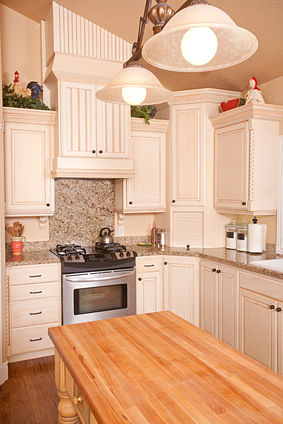Butcher Block Countertop
The butcher block countertop has been a favorite for many generations. Hard Sugar Maple is the most popular of all the butcherblock countertops, but almost any wood can be used.
Although you could cut on these tops it's better to use a cutting board or some other form of protection. Scratches and stains can be sanded away easily. It is wood, so burns to this top are possible, due to it's inability to disperse heat.
Butcher block countertops have the ability to blend into almost any kitchen style. Their neutral tones compliment other countertop materials, be it man-made or natural. Natural woods have a warm look and feel and are well placed in any kitchen. I particularly like the look of butcher block on a kitchen island with other materials on the rest of the tops. It makes the overall kitchen look more inviting.
 |
Construction and Woods Used:
My most loved butcher block countertop is the slab style made of Hard Rock Maple. What is slab style? I'm glad you asked! Slab style is taking a very thick slab of wood and removing the bark and leaving the natural tree shape around the edges. This is done by sawing the tree down the length and all in one piece. It may be necessary to glue two sections together to make a top that's wide enough.
There are some drawbacks to this style though. The tree has be dried out thoroughly to prevent the wood from splitting, or checking. It also has to be quite thick, two inches or more. The extra thickness gives the top a more substantial look and feel.
Common woods used are Maple, Cherry, Oak, and Mahogany. More exotic types are Wenge, Teak, Walnut, Zebrawood, Bamboo, and Ironwood. This is only a small list of the most common woods used, any wood you can think of can be used. Using a local wood is also a great idea. Any woodworking craftsman should be able to make these tops so finding a craftsman should not be too difficult.
The most common construction method is gluing smaller strips together. This is also makes more stable butcher block countertops and is less likely to split. This method is generally less expensive as well.
Another construction type is the end grain exposed type. Short blocks of wood, usually 2 1/2", are glued together on end with the end grains showing. The benefit of this is the ability to design patterns in the wood with different types of wood. Checkered for example. These tops are said to be more durable as well. The price is more expensive though with more time needed to make this style.
Finishes:
If you don't plan to use the top for food preparation, a two part polyurethane can be used to give it the bar top look. Like a sheet of glass encasing the wood.
If you do plan to use it a food prep area then leaving it natural or applying mineral oil or another type of food safe preservative is recommended. If a preservative is used then regular maintenance is going to be required.
A Great Benefit:
Wood is also has anti microbial properties. Bacterial is killed by the natural occurring chemicals in the wood itself. Completely safe to us humans but not to bacteria. Regular cleaning and disinfecting is still required to minimize the risk. I recommend looking into this further, just to inform yourself on this subject.
Thicknesses:
Butcherblock countertops come in thicknesses of 3/4" to 3", with 1 1/2" being the standard. I recommend the top be as thick as you like with the minimum being 1 1/2". This is for longevity and stability, stability being the most important because stability will ultimately lead to better longevity.
In Summary:
The durability of butcher block countertops are great. I remember a local butcher shop when I was kid having maple butcher block that was hollowed out from years of cutting. How many years? 50, yup 50 years of continuous cutting day in day out and it probably had 50 more years left in it. That just goes to show you these tops are very long lived.
It doesn't matter which way you go with your countertops, it's your personal preference. Others will tell you that you HAVE to do it their way, but it's your kitchen do what you feel is best for you.




